Six hundred generations of Tribal interconnectedness with Buffalo were effectively terminated with the en masse slaughter of this keystone species over a 50-year period in the late 1800s. The Idaho Conservation League regards both cultural and ecological benefits of bison as important reasons to understand how they might be returned to more western landscapes—including places in Idaho.
The following entry is one in a series of blog articles on bison that accounts our ongoing efforts to gain awareness and knowledge in pursuit of this goal.
As I arrived in the waning hours of daylight, a thickening brown haze enveloped Jackson Hole. It dropped into the valley from Wyoming’s Togwotee Pass area, where a smoldering fire had suddenly blown up some 50 miles north of the resort town. I had to plan for an early start the next morning to make sure I could squirt through the notch in the glaciated peaks and hanging alpine valleys before Wyoming Department of Transportation shut that ribbon of highway down to all manner of commerce rigs, van-lifers, and cyclists in the name of public safety.
I was on a two-day whirlwind excursion to learn more about inspirational Tribal Buffalo restoration initiatives happening on Wind River Indian Reservation lands in Wyoming. I spent that night in my truck off a washed-out road on the Bridger-Teton National Forest, just east of the National Elk Refuge. Despite my stopover near the center of the universe for the conservation of Rocky Mountain elk, there was not a single elk to be seen as I headed out of town. But, as the French roast kicked in and I made my way up the valley, the dark shapes of a much larger bovid began emerging from the grasses to the east of Highway 89.
The Buffalo lingered in the Antelope Flats area while tourists observed the shaggy, lumbering behemoths from uncomfortably close distances—at least from the perspective of one who was witnessing the spectacle as a passerby. For the visitors, the indelible encounter was with some of the 500 bison that make their home in the shadow of the Teton Range, moving between Grand Teton National Park and the elk refuge. But this was not the herd I had set out to gain a better understanding of. Those animals were still several hours away, over the hill, on the Wind River Indian Reservation.
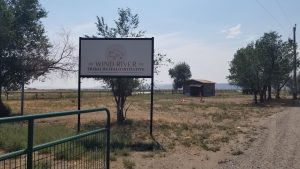
The roots of the Wind River Tribal Buffalo Initiative
When I arrived at the Wind River Tribal Buffalo Initiative (WRTBI) offices, my host, Jason Baldes, was preoccupied on a call while sitting in his pickup. It quickly became apparent he had a lot on his plate. Jason’s efforts to restore Buffalo to his Wind River homeland and the shared territory of the Eastern Shoshone and Northern Arapaho Tribes has been the talk in bison conservation circles for a decade. Every so often, as a youngster, Jason wondered aloud “why don’t we have any Buffalo?” His father, Richard, had worked tirelessly as a fisheries biologist for the U.S. Fish and Wildlife Service, collecting data on the health of a 55-mile section of the “Big Wind” River watershed within the reservation which had become impaired. In the 1980s, enforcement of Tribal sovereignty ultimately provided a means to protect the riparian area, and the health of reservation land, using the fish population estimates and habitat surveys that Richard had produced.
In the late 1990s, Jason and Richard visited Tanzania and Kenya, and observed expansive herds of migrating wildebeests, crossing the vast plains of the Masai Mara and the Serengeti. “When I came back I kind of had an epiphany—a newfound appreciation,” Jason told me, “It was a lightbulb moment, for sure…it was a seed.”
Upon their return, he began to correlate the experience in east Africa to his own ancestral connections to the keystone species of “America’s Serengeti” that once roamed his Tribal territory. He said, “I had a newfound appreciation for where I came from—Shoshone people, Arapaho people, people that had this relationship with Buffalo” and that he came to “understand that the one (natural world) I was coming from had just as much credibility and legitimacy that maybe wasn’t appreciated as much (before his travels).”
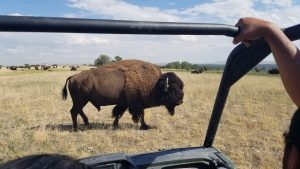
From humble beginnings come buffalo-sized things
Bison haven’t existed on Eastern Shoshone and Northern Arapaho lands since 1885. But, in 2014, the “seed” of restoring Buffalo to the Wind River Indian Reservation sprouted from a father and son’s journey. It emerged on 300 acres, after Baldes obtained support for the project from the Tribe’s Council. The chunk of land had been purchased back by the Shoshone Tribe in the late 1980s, after areas north of the Wind River and part of the original boundaries of the reservation had been opened up for homesteading. Since that time, the Wind River Tribal Buffalo Initiative, as a nonprofit organization, has raised over $9 million to buy land back around that original parcel, to hire a modest staff, work with graduate students, and purchase equipment.
The WRTBI herd’s beginnings came in 2016, from 10 animals originating in Neal Smith National Wildlife Refuge, just east of Des Moines, Iowa. The following year, 10 more were released from the National Bison Range on the Flathead Reservation in Montana (now managed as the CSKT Bison Range by Confederated Salish and Kootenai Tribes). Now, some 160 bison roam over 1,200 acres of Wind River Indian Reservation lands, representing what is likely the world’s most genetically diverse population of Tribal bison.
Headquarters for WRTBI is a heady place. Isolated on a stretch of highway in Fremont County, Wyoming, north of Lander, the offices serve as one part research station for the Buffalo initiative and one part incubation facility for the essential exchange of creative conservation ideas. On any given day, the large kitchen table at the comfy two-story ranch house hosts thinkers and doers from all across the west whose work overlaps with WRTBI’s efforts. That day, by chance, my visit coincided with the arrival of Kyle Trujillo and Red Thunder from Ancestral Lands Conservation Corps in Albuquerque, and Phillip Chavez from Trees, Water & People, based in Fort Collins. Red Thunder and Phillip were both raised on the Wind River Reservation, mentored at times by Jason, and then left to pursue college educations elsewhere. They had both returned to their homeland for a couple days, representing NGOs whose work has a nexus with bison restoration efforts on the reservation. Sitting at the table, I quickly came to understand that the early successes of WRTBI are a shared celebration and rely on continued contributions of Indigenous knowledge to grow the program.
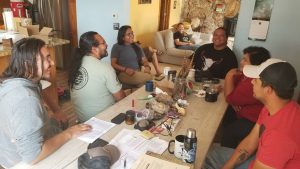
“It’s time to go feed the calf” 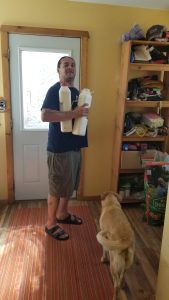
Eventually, Jason rose from his seat in the living room and beckoned, “It’s time to go feed the calf.” This spring, a yellow baby bison had been discovered in the floodplain of the river, after being abandoned by its mother. Four months and hundreds of gallons of lamb formula later, it’s now a shade larger than the rest of its cohort and has generally been assimilated into the herd. It was just a week or two from being completely weaned and switched over to 100% natural forage.
Jason and I jumped in the side-by-side along with Kyle, Phillip, and Red Thunder. Xavier, WRTBI’s only other full-time staffer, followed closely behind. We headed through a stout fenceline and into an adjacent field on a high bluff above the “Big Wind.” As we approached, the herd accommodated our presence, seeming to understand our mission. The surprisingly shallow buffer of protection they did maintain was likely determined by maternal instincts over still vulnerable offspring. The rut was just wrapping up and a few dominant bulls were still looking for final dances before the bar closed. A good-sized calf emerged from the group and began wandering in our direction. Jason parked the buggy and shut off the motor. A tapestry of grunts and snorts and swishing tails immediately filled the air, no longer being drowned out by the prattling of our rig. Dozens of brown-black eyes fixed on us as the calf moved closer and eventually took a broadside stance next to Jason. It fed eagerly, and emptied two 3-quart bottles in minutes before sauntering back to the group. Then we lingered. Not a word was spoken. We just listened. And were taken by the overwhelming presence of the animals.
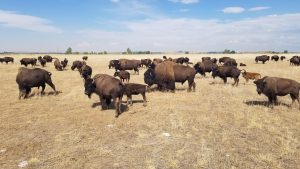
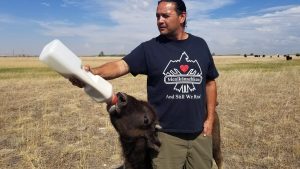
Rematriation
When we returned to the living room, Jason spoke with solemnity and reverence for the undertaking that is the Wind River Tribal Buffalo Initiative. “Buffalo restoration is not just about ecological importance, it’s also about cultural and spiritual importance, it’s about healing, it’s about our young people, and women and elevating matriarchy which is how it used to be and it’s modeled after the Buffalo…the goal is ‘more land, more buffalo’.” He calls the process “Rematriation – restoring keystone species and land ownership to Tribes…giving back to Mother Earth, bringing back a holistic connection, and empowering the role of women.” He told me, “We come from Buffalo people. They’ve been gone for so long that it’s like bringing home a long lost relative. It has implications in many of the things we’re doing, from health and education to land use change and land acquisition to water rights and carbon storage and biodiversity. It touches everything that we do, it’s foundational to who we are as people as both tribes (Eastern Shoshone and Northern Arapaho). I think bringing them back allows us to think outside that box that we’ve been forced in, ways of thinking, ways of knowing and understanding—what we build around ourselves and what we fence ourselves in on, boxes all around us—for us, a circle is more important and there’s a lot of meaning in the circle and how that translates to our relationship with land and water and animals, how we relate to each other, how we relate to ourselves. Thinking outside the box means thinking more cyclical in understanding the inner relationality of what Buffalo mean for tribal communities.”
His parting words filled my thoughts and trotted alongside my truck on my long return home. My experience of this creature will forever occupy a different, more expansive place. It will be carried forward in ICL’s pursuit to better understand how bison might be returned to additional western landscapes—including important places in Idaho.
You can help to restore and protect Buffalo and rekindle the cultural and spiritual connection of Native peoples to Buffalo by supporting the vital work of the Wind River Tribal Buffalo Initiative. To make a donation, click here.
As ICL dives deeper into working toward our goal of restoring bison to public lands in Idaho, we are deeply grateful to learn from and be inspired by the work of the WRTBI. To make a donation to support ICL’s wildlife program, click here.
